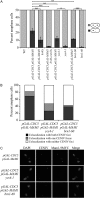Condensins promote coorientation of sister chromatids during meiosis I in budding yeast
- PMID: 20194961
- PMCID: PMC2870976
- DOI: 10.1534/genetics.110.115139
Condensins promote coorientation of sister chromatids during meiosis I in budding yeast
Abstract
The condensin complex is a key determinant of higher-ordered chromosome structure. We show here that the complex is also important for the correct alignment of chromosomes on the meiosis I spindle. Unlike during mitosis and meiosis II, when sister chromatids attach to microtubules emanating from opposite spindle poles (biorientation), accurate meiosis I chromosome segregation requires that sister chromatids attach to microtubules emanating from the same spindle pole (co-orientation). The monopolin complex, consisting of Lrs4, Csm1, and the meiosis-specific component Mam1, brings about meiosis I co-orientation. We find that in the absence of functional condensin complexes, a fraction of sister kinetochores biorient on the meiosis I spindle and association of the monopolin complex subunit Mam1 with kinetochores is decreased. Our studies uncover a new locus-specific effect of the condensin complex.
Figures







References
-
- Amon, A., 2002. Synchronization procedures. Methods Enzymol. 351 457–467. - PubMed
-
- Chelysheva, L., S. Diallo, D. Vezon, G. Gendrot, N. Vrielynck et al., 2005. AtREC8 and AtSCC3 are essential to the monopolar orientation of the kinetochores during meiosis. J. Cell Sci. 118 4621–4632. - PubMed
-
- Clyne, R. K., V. L. Katis, L. Jessop, K. R. Benjamin, I. Herskowitz et al., 2003. Polo-like kinase Cdc5 promotes chiasmata formation and cosegregation of sister centromeres at meiosis I. Nat. Cell. Biol. 5 480–485. - PubMed
Publication types
MeSH terms
Substances
Grants and funding
LinkOut - more resources
Full Text Sources
Molecular Biology Databases

